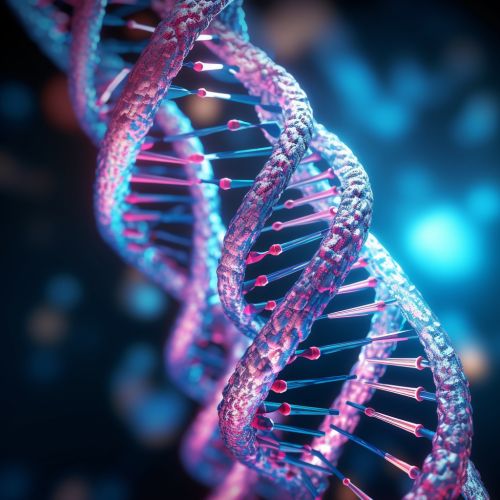Transcription (genetics)
Overview
Transcription in genetics is a process where the DNA sequence of a gene is transcribed (copied out) to make an RNA molecule. This RNA molecule can then be used to produce a protein. The stretch of DNA transcribed into an RNA molecule is called a transcription unit and encodes at least one gene.


Process of Transcription
The process of transcription can be divided into three stages: initiation, elongation, and termination.
Initiation
Transcription begins with the binding of RNA polymerase to the promoter sequence on the DNA (in prokaryotes, this is typically a Pribnow box, while in eukaryotes, this is typically a TATA box). The RNA polymerase is a key player in the process of transcription. It is an enzyme that synthesizes an RNA strand from a DNA template strand.
Elongation
Once the RNA polymerase has bound to the promoter, the DNA strands unwind, and the polymerase begins RNA synthesis at the start point on the template strand. The RNA product is extended with the RNA polymerase translocating along the DNA template and synthesizing the RNA transcript.
Termination
In prokaryotes, termination of RNA transcription can be rho-dependent or rho-independent. In eukaryotes, termination involves cleavage of the new transcript followed by template-independent addition of adenines at its new 3' end, in a process called polyadenylation.
Types of RNA
There are three main types of RNA that are transcribed from DNA: messenger RNA (mRNA), ribosomal RNA (rRNA), and transfer RNA (tRNA). Each of these types of RNA plays a different role in the cell.
Messenger RNA
mRNA carries the genetic information copied from DNA in the form of a series of three-base code “words,” each of which specifies a particular amino acid.
Ribosomal RNA
rRNA associates with a set of proteins to form ribosomes. These complex structures, which physically move along an mRNA molecule, catalyze the assembly of amino acids into protein chains.
Transfer RNA
tRNA is the key to deciphering the codons in mRNA. Each type of tRNA molecule can be attached to only one type of amino acid, so each carries a specific amino acid to the ribosome to be added to the growing protein chain.
Transcription Factors
In eukaryotes, transcription is controlled by a complex system of transcription factors. These are proteins that bind to specific DNA sequences and interact with the RNA polymerase to either increase or decrease the rate of transcription.
Transcription vs. Replication
Transcription should not be confused with replication, the process of making an exact copy of a DNA molecule. While both processes involve the synthesis of a new strand of DNA or RNA, the purpose and result of these processes are very different.
